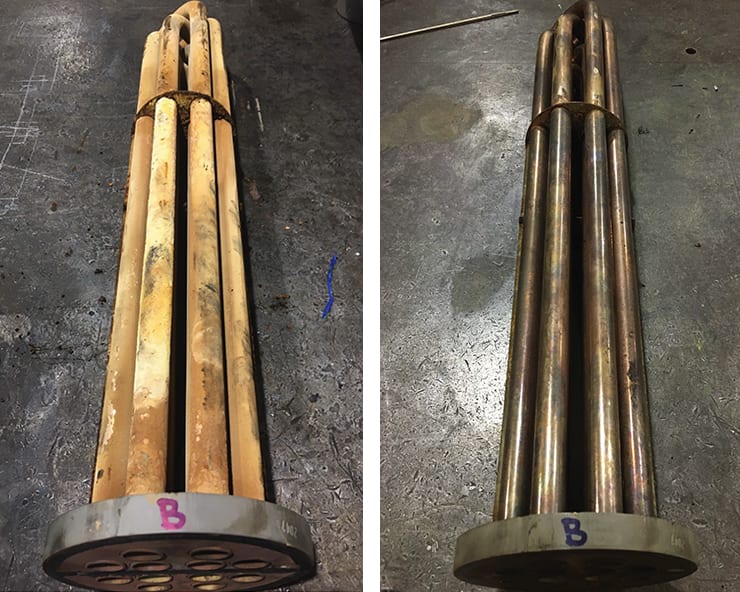SHELL & TUBE HEAT EXCHANGER DESCALING
A tire & rubber manufacturer was experiencing heat transfer issues as water scale had accumulated on the shell side of their heat exchangers. Plant personnel quickly turned to RYDLYME Biodegradable Descaler to dissolve these issues and perform a shell & tube heat exchanger descaling. In addition to the use of RYDLYME, the plant decided to pair the biodegradable descaler with our specially built industrial descaling system, the PumpMaster 115v. This pump system is perfect for small cleanings such as this sub-10-gallon heat exchanger.
The mechanical engineers circulated 1 gallon of RYDLYME diluted with 3 gallons of water using the PumpMaster 115v for 1 hour. The plant staff was ecstatic with the results of the cleaning and are excited to see their efficiency return! Other equipment applications throughout the plant are now being inspected for scale and RYDLYME will be applied there in conjunction with a larger pumping system for the increased volume. Preventative maintenance schedules are now being designed which specify cleaning with RYDLYME.
Shell and Tube Heat Exchanger Cleaning Procedure
Apex Engineering Products has been around for more than 75 years manufacturing safe chemical solutions, so we know our way around a heat exchanger.
- Isolate and drain the water side of the exchanger to be cleaned.
- Place a 1” ball valve between the isolation valves and the heat exchanger on both the supply and return.
- Attach the RYDLYME pump and hoses so the RYDLYME will be pumped in the bottom or supply, and back out the top or return.
- Begin pumping all the required RYDLYME into the exchanger. Once that is accomplished, begin to add water to complete the circulation. Please note: The calcium deposit will take up volume within the heat exchanger, so you will not be able to add the same amount of water in the beginning.
- Continue circulating the solution for the recommended amount of time. As the circulation progresses and the product dissolves the deposits inside the unit, the volume will increase. To account for the increase in volume, please add water to the circulation vessel, as needed. If you begin adding a lot of water, please be aware, it is possible there is a leak in the system.
- It is a good idea to periodically check the effectiveness of the solution while circulation is in progress. This can be accomplished by utilizing a pH meter and as long as the solution retains a low pH, the product is active. Should the circulating solution reach a pH of 5.5 to 7.0 before the recommended time is up, you will need to add more RYDLYME and possibly extend the circulation time.
- Upon completion of the recommended circulation time, the solution may be purged to a normal sewer and flushed with water. This process is completed by placing the return hose in the drain and adding water to the circulation container until the discharge line runs clear.
- The unit is ready to be returned to service.
- The same instructions may be used for plate and frame-type heat exchangers. For volumes, please follow the noted formula.
Please note: If your situation dictates that you cannot take your heat exchanger off-line, please contact the manufacturer for online cleaning instructions.


